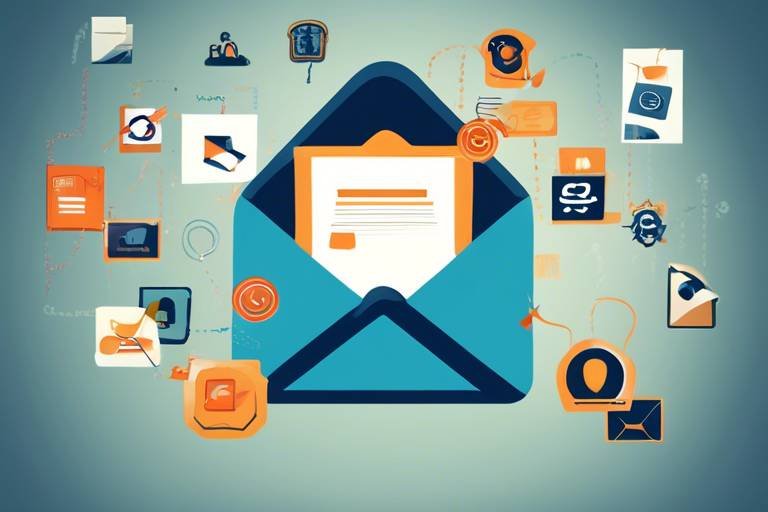How to Protect Your Online Identity from Theft
In today's digital age, protecting your online identity is more crucial than ever. With the rise of technology, our personal information is constantly at risk. From social media platforms to online banking, every click and share can expose you to potential threats. But don't worry! This article is here to arm you with essential strategies and tips that will help you safeguard your online identity from theft. Think of it as building a digital fortress around your personal information—strong, secure, and impenetrable.
Online identity theft is a serious crime that involves stealing someone's personal information, such as their name, social security number, or bank details, to commit fraud. It's like a thief breaking into your home, but instead of physical possessions, they’re after your identity. The prevalence of identity theft is alarming; according to recent statistics, millions of people fall victim each year. Awareness is the first step toward prevention. Knowing how thieves operate can help you stay one step ahead. They often use methods like phishing, hacking, and social engineering to gather your information. Understanding these tactics is key to protecting yourself.
Cybercriminals are crafty and resourceful. They employ a variety of tactics to gain access to sensitive information. Here are some of the most common methods:
- Phishing: This involves tricking individuals into providing personal information through fake emails or websites.
- Hacking: This is when criminals exploit vulnerabilities in software or networks to steal data.
- Social Engineering: This technique manipulates individuals into divulging confidential information by building trust.
Phishing attacks are one of the most prevalent forms of identity theft. They typically come in the form of emails that look legitimate but are actually designed to trick you into providing sensitive information. Imagine receiving an email that appears to be from your bank, asking you to verify your account details. It’s alarming, isn’t it? Recognizing these scams is essential for your safety.
Phishing is not a one-size-fits-all tactic. There are several variations, including:
- Spear Phishing: Targeted attacks aimed at specific individuals or organizations.
- Whaling: A more sophisticated form of phishing that targets high-profile individuals, such as executives.
To protect yourself from phishing scams, be vigilant. Look for these red flags:
- Unusual sender email addresses.
- Generic greetings like "Dear Customer."
- Urgent language that creates panic.
- Links that don’t match the website they claim to be from.
Always verify the source before clicking on any links or providing information.
Social engineering is a cunning tactic used by criminals. They manipulate individuals into giving away personal information by exploiting human psychology. It’s like a con artist gaining your trust before robbing you blind. They might pose as a tech support agent or a friend in need. Always be cautious and verify identities before sharing any information.
Now that you understand the threats, let’s dive into some best practices for maintaining your online security. Implementing these strategies can significantly reduce your risk of becoming a victim:
One of the simplest yet most effective ways to protect your online identity is by using strong passwords. A strong password is like a sturdy lock on your front door. It should be complex, containing a mix of uppercase letters, lowercase letters, numbers, and special characters. Consider using a password manager to help you generate and store secure passwords. Remember, the longer and more complex your password, the harder it is for cybercriminals to crack it.
Two-factor authentication (2FA) is another layer of security that can protect your accounts. Think of it as a double lock on your door. Even if someone manages to get your password, they won’t be able to access your account without the second form of verification. Most platforms offer 2FA, and enabling it is a simple step you can take to enhance your security.
Regularly monitoring your online presence is vital. This means keeping an eye on your social media accounts and any personal information that may be floating around the internet. Set Google alerts for your name to stay informed about any mentions online. This proactive approach can help you detect unauthorized use of your information before it spirals out of control.
Consider investing in identity theft protection services. These services monitor your personal information and alert you to suspicious activity. They act as a safety net, providing peace of mind in an increasingly digital world. While no service can guarantee complete protection, they can significantly reduce your risk and help you respond quickly if your identity is compromised.
If you ever find yourself a victim of identity theft, it’s crucial to act fast. Start by reporting the incident to your bank and any affected accounts. Freeze your credit to prevent new accounts from being opened in your name. Document everything and consider filing a report with the Federal Trade Commission (FTC). The quicker you respond, the better chance you have of mitigating damage.
Q: What should I do if I suspect my identity has been stolen?
A: Act quickly! Report the theft to your bank, freeze your credit, and file a report with the FTC.
Q: How can I create a strong password?
A: Use a mix of letters, numbers, and symbols. Aim for at least 12 characters and avoid easily guessed information.
Q: Is two-factor authentication really necessary?
A: Yes! It adds an extra layer of security that can help protect your accounts even if your password is compromised.

Understanding Online Identity Theft
In today's digital landscape, where everything from shopping to socializing occurs online, the concept of online identity theft has become alarmingly prevalent. But what exactly is it? Simply put, online identity theft occurs when someone unlawfully obtains and uses your personal information—such as your name, Social Security number, or credit card details—without your consent. This can lead to a myriad of problems, including financial loss, damaged credit scores, and even legal troubles. The reality is, as we continue to embrace technology, the risk of our identities being compromised only increases.
To better understand the gravity of the situation, consider this: according to recent statistics, millions of people fall victim to identity theft each year, with a growing number of cases reported each day. The methods employed by criminals are becoming more sophisticated, making it crucial for individuals to stay informed and vigilant. Awareness is not just the first step; it's the most vital step toward prevention.
Criminals often exploit various tactics to steal personal information. They might use malware to infiltrate your devices, or resort to social engineering techniques that manipulate you into revealing sensitive information. It's like a game of chess, where the stakes are your identity. Understanding how these tactics work can help you recognize potential threats and take proactive measures to protect yourself.
Consider the following common methods used by cybercriminals:
- Phishing: Sending fraudulent emails or messages that appear to be from legitimate sources to trick you into providing personal information.
- Hacking: Gaining unauthorized access to your accounts or devices, often through weak passwords or security vulnerabilities.
- Social Engineering: Manipulating individuals into divulging confidential information by exploiting human psychology.
By familiarizing yourself with these tactics, you can better prepare yourself to combat them. Remember, the more you know about how identity theft works, the more equipped you'll be to safeguard your personal information. It's akin to knowing the enemy's playbook before entering the game. Stay informed, stay alert, and most importantly, stay one step ahead of those who seek to exploit your identity.

Common Tactics Used by Cybercriminals
In the vast digital landscape, cybercriminals are constantly evolving their tactics to exploit unsuspecting individuals. Understanding these methods is crucial because knowledge is your first line of defense. Identity theft can happen to anyone, and it often occurs without warning. Imagine waking up one day to find that your personal information has been hijacked—it's a nightmare scenario that is all too real for many. So, what are the most common tactics used by these digital bandits? Let's dive in and explore.
One of the primary methods cybercriminals use is phishing. This deceptive technique involves tricking individuals into providing sensitive information, such as passwords or credit card numbers, by masquerading as a trustworthy entity. Phishing can occur through various channels, including emails, text messages, or even social media. Just think of it as a digital fisherman casting a wide net, hoping to catch unsuspecting victims who nibble at the bait. The art of phishing has become so refined that many people find it challenging to distinguish between legitimate messages and scams.
Phishing attacks come in many flavors, each designed to manipulate the victim's perception. For instance, spear phishing targets specific individuals or organizations, making it highly effective. Imagine receiving an email that appears to be from your bank, complete with their logo and formatting. It might request that you verify your account information urgently. This kind of targeted approach can make even the most cautious individuals second-guess themselves.
To further complicate matters, there are various types of phishing techniques. Here are a few notable ones:
- Spear Phishing: Targeted attacks aimed at specific individuals.
- Whaling: A more sophisticated form of spear phishing that targets high-profile individuals like executives.
- Clone Phishing: A previously delivered legitimate email is cloned and sent with a malicious link.
Each of these tactics has its unique characteristics, but they all rely on the same principle: deception.
Recognizing phishing scams is vital for safeguarding your online identity. Here are some red flags to watch for:
- Unusual sender addresses or domains that don't match the company’s official website.
- Urgent language that pressures you to act quickly.
- Generic greetings instead of personalized messages.
- Links that lead to unfamiliar or suspicious websites.
By staying vigilant and aware of these indicators, you can better protect yourself from falling victim to these deceptive tactics.
Another prevalent tactic is social engineering, where criminals manipulate individuals into revealing confidential information. This method often involves exploiting human psychology rather than technical vulnerabilities. For example, a cybercriminal might call you, pretending to be a tech support agent, and ask for your password to "fix" an issue. It's akin to a con artist playing on your trust and emotions, making you feel safe enough to divulge your secrets.
Cybercriminals are skilled at crafting believable scenarios that can leave you feeling vulnerable. They might use personal information gleaned from social media to make their approach seem more legitimate. This highlights the importance of being cautious about what you share online. Remember, your personal information is like a treasure chest; the more you expose it, the easier it is for thieves to break in.
In conclusion, the tactics employed by cybercriminals are diverse and sophisticated. By understanding these methods, you can arm yourself with the knowledge necessary to protect your online identity. Always be skeptical of unsolicited communications, and never hesitate to verify the authenticity of requests for sensitive information. Your online safety is in your hands!
Q: What should I do if I think I've been a victim of phishing?
A: If you suspect you've fallen for a phishing attempt, immediately change your passwords and enable two-factor authentication on your accounts. Report the incident to your bank or the relevant service provider.
Q: How can I protect myself from social engineering?
A: Be cautious about the information you share online and verify the identity of anyone asking for sensitive information. Always trust your instincts—if something feels off, it probably is.

Phishing Attacks
Phishing attacks are one of the most prevalent and insidious forms of online identity theft. Imagine receiving an email that looks like it’s from your bank, complete with logos and branding, asking you to verify your account information. You might think it’s legitimate, but this is exactly what cybercriminals want you to believe. Phishing is a tactic where attackers impersonate trusted entities to trick individuals into revealing sensitive information, such as usernames, passwords, and credit card numbers. The sheer volume of phishing attempts is staggering, with millions of such emails sent daily across the globe.
Phishing attacks can take many forms, and understanding these can be your first line of defense. For instance, there are email phishing attacks, where a fraudulent email prompts you to click on a malicious link. Then there's SMS phishing, or "smishing," where text messages are used to lure you into providing personal information. Even phone calls can be a part of this scheme, known as vishing (voice phishing), where attackers pose as legitimate representatives to extract valuable data.
To help you recognize phishing attempts, here are some common red flags to watch out for:
- Generic Greetings: Phishing emails often use generic greetings like "Dear Customer" instead of your name.
- Urgent Language: Scammers create a sense of urgency, claiming that your account will be suspended unless you act immediately.
- Suspicious Links: Hover over any links to see where they lead. If the URL looks strange or doesn't match the supposed sender, don't click it!
- Unusual Attachments: Be wary of emails that include attachments, especially if you weren't expecting them.
Recognizing these signs can drastically reduce your chances of falling victim to a phishing attack. But what should you do if you suspect an email is a phishing attempt? First, don’t engage with the email—do not click any links or download attachments. Instead, report the phishing attempt to your email provider and delete the message. If you’ve already clicked a link or provided information, change your passwords immediately and monitor your accounts for any unauthorized activity.
In conclusion, phishing attacks are a significant threat in the digital age, and awareness is your best defense. By staying informed about how these scams operate and knowing what to look for, you can protect your personal information and keep your online identity secure.

Types of Phishing
When it comes to online threats, phishing is like a chameleon—always changing its colors to blend in and trick unsuspecting victims. Understanding the different types of phishing is crucial for safeguarding your personal information. Let's dive into the murky waters of phishing tactics, shall we?
At its core, phishing is a method used by cybercriminals to deceive individuals into providing sensitive information, such as usernames, passwords, or credit card details. These scams often masquerade as legitimate communications from trusted sources. However, not all phishing attempts are created equal. Here are some of the most common types:
- Spear Phishing: Unlike generic phishing attacks that cast a wide net, spear phishing is highly targeted. Cybercriminals gather personal information about their victims, such as their work history or social connections, to craft personalized messages that appear credible. This makes it easier for them to manipulate individuals into divulging confidential information.
- Whaling: If spear phishing is like fishing for small fish, whaling is the big game hunt. This tactic targets high-profile individuals, such as CEOs or financial officers, often using highly sophisticated and personalized approaches. The stakes are higher, and the potential rewards for the attacker are substantial.
- Clone Phishing: In this technique, attackers create a nearly identical replica of a legitimate email that the victim has previously received. The only difference? The link or attachment has been replaced with a malicious one. This method exploits the victim's trust in the original email, making it more likely that they will click on the new link.
- Vishing: Voice phishing, or vishing, takes the phishing game to a new level by using phone calls instead of emails. Attackers often impersonate legitimate organizations, such as banks or government agencies, to extract sensitive information. Imagine receiving a call that sounds official—it's easy to get caught off guard!
- Smishing: Short for SMS phishing, smishing involves sending fraudulent text messages to trick individuals into revealing personal information. With the rise of mobile device usage, this method is becoming increasingly prevalent. A simple text claiming you've won a prize could lead you down a dangerous path.
Recognizing these various types of phishing is essential for protecting yourself. Each method has its unique characteristics, but they all share a common goal: to deceive you into giving up your personal information. By being aware of these tactics, you can better prepare yourself to spot the red flags and avoid falling victim.
In summary, whether it's spear phishing, whaling, clone phishing, vishing, or smishing, understanding the types of phishing attacks is your first line of defense. Just like a skilled detective, you need to analyze the clues and trust your instincts. If something feels off, it probably is!

How to Spot Phishing Scams
In today's digital landscape, phishing scams have become alarmingly sophisticated, making it crucial for you to be vigilant. So, how can you protect yourself from these deceptive tactics? First, it’s essential to understand that phishing attempts often masquerade as legitimate communications from trusted sources. These could be emails, messages, or even social media notifications that seem to be from your bank, a popular online service, or a friend. The key to spotting these scams lies in recognizing certain telltale signs.
One of the most common indicators of a phishing scam is the urgency conveyed in the message. Scammers often create a sense of panic, urging you to act quickly to avoid dire consequences. For instance, you might see phrases like “Your account will be suspended unless you verify your information immediately!” This is a classic tactic aimed at bypassing your critical thinking. Always take a moment to breathe and analyze the situation before clicking on any links or providing personal information.
Another red flag is poor grammar and spelling. Many phishing emails are hastily crafted and may contain numerous typos or awkward phrasing. Legitimate organizations usually have a professional standard for their communications, so if you notice something that seems off, it’s worth investigating further.
Moreover, look closely at the sender's email address. Phishers often use addresses that closely resemble those of legitimate companies but may have minor alterations, such as an extra letter or a different domain. For example, instead of “support@bank.com,” you might see “support@bank-secure.com.” Always double-check the sender's information before taking any action.
Here are some additional tips to help you spot phishing scams:
- Hover Over Links: Before clicking, hover your mouse over the link to see the actual URL. If it looks suspicious or doesn’t match the context of the message, don’t click it.
- Check for Personalization: Legitimate companies often address you by your name. If the email starts with “Dear Customer” or something vague, it could be a scam.
- Be Wary of Attachments: Unexpected attachments can contain malware. If you weren’t expecting a file, it’s best to delete the email.
Ultimately, staying informed and cautious is your best defense against phishing scams. If something feels off, trust your instincts. Report suspicious messages to your email provider or the organization that appears to be contacting you. Remember, it’s better to be safe than sorry!

Social Engineering Techniques
When we think about identity theft, we often picture hackers stealthily breaking into our accounts, but the reality is far more insidious. One of the most effective methods used by cybercriminals is social engineering. This technique exploits human psychology rather than technical vulnerabilities. Imagine a magician who tricks you into believing something is real when it’s not; that’s exactly what social engineers do. They manipulate individuals into divulging personal information, often by creating a sense of urgency or fear.
Social engineering can take many forms, and it’s essential to recognize the tactics used by these deceitful individuals. For instance, they might pose as a trusted figure, like a bank representative or a tech support agent, to gain your trust. This tactic is often referred to as pretexting, where the attacker creates a fabricated scenario to steal your information. Another common approach is baiting, where they offer something enticing, like free software or a prize, to lure you into providing sensitive data.
Here are some common social engineering techniques to be aware of:
- Phishing: This involves sending emails or messages that appear legitimate but are designed to steal your information.
- Vishing: This is a voice phishing technique where attackers use phone calls to extract personal information.
- Spear Phishing: Unlike regular phishing, this targets specific individuals or organizations with tailored messages.
- Pretexting: The attacker poses as someone with a legitimate reason to obtain your information.
Understanding these techniques is crucial in protecting yourself from becoming a victim. For example, if you receive an unexpected email requesting sensitive information, it’s wise to verify the source before responding. Trust your instincts; if something feels off, it probably is. Always double-check the sender's email address and look for any spelling errors or unusual links. These red flags can be your first line of defense against social engineering attacks.
Moreover, social engineering isn’t just limited to the digital world. It can also happen in person. For instance, someone might attempt to gain access to a secure area by pretending to be a maintenance worker or a delivery person. This highlights the importance of being vigilant in all aspects of your life. Always question the legitimacy of requests for sensitive information, whether online or offline.
In summary, social engineering is a crafty and manipulative way that criminals exploit human behavior to commit identity theft. By staying informed and cautious, you can significantly reduce your risk of falling victim to these deceptive tactics. Remember, it’s not just about having strong passwords or two-factor authentication; it’s also about being aware of the psychological tricks that could lead to your personal information being compromised.

Best Practices for Online Security
In today’s digital age, protecting your online identity is more crucial than ever. With cyber threats lurking around every corner, adopting can significantly reduce your risk of identity theft. Think of your online presence as a house; if you leave the doors and windows wide open, it’s only a matter of time before someone breaks in. So, how do you fortify your digital home? Here are some essential strategies to consider.
First and foremost, strong passwords are your first line of defense. A password is like the key to your house; if it's weak, anyone can get in. To create a robust password, consider using a combination of uppercase letters, lowercase letters, numbers, and special characters. For example, instead of using “password123,” opt for something like “P@ssw0rd!2023.” Not only is it harder to guess, but it also makes it more challenging for hackers to crack through brute force methods.
But here’s the kicker: remembering all those complex passwords can be a nightmare! That’s where password managers come into play. These handy tools can generate and store your passwords securely, allowing you to focus on more critical aspects of your online security. Just remember, even with a password manager, you should still use a strong master password to protect your vault.
Another vital practice is enabling two-factor authentication (2FA). Imagine it as having a second lock on your door. Even if someone manages to get your password, they would still need a second form of verification to gain access. This could be a text message sent to your phone, an email, or an authentication app. Enabling 2FA on your accounts can significantly enhance your security. Most major platforms, such as Google, Facebook, and Amazon, offer this feature, so take advantage of it!
Moreover, keeping your software updated is crucial. Software updates often contain patches for security vulnerabilities that hackers can exploit. Just like you wouldn’t leave a broken window in your house, don’t ignore those update notifications. Regularly updating your operating system, browsers, and applications ensures you have the latest security features and fixes, making it harder for cybercriminals to breach your defenses.
Lastly, be aware of your online behavior. This means being cautious about the information you share on social media. Oversharing can lead to identity theft, as cybercriminals can piece together personal details to impersonate you. Always check your privacy settings and be selective about who can see your posts. If you wouldn’t invite a stranger into your living room, don’t let them into your online life!
In summary, following these best practices for online security is essential for safeguarding your identity in an increasingly digital world. By using strong passwords, enabling two-factor authentication, keeping your software updated, and being mindful of your online presence, you can build a robust defense against identity theft. Remember, the goal is to make it as difficult as possible for cybercriminals to access your personal information.
- What is the most important step to protect my online identity?
Using strong, unique passwords for each of your accounts is crucial. - How can I tell if my accounts have been compromised?
Look for unusual activity, such as unrecognized logins or changes to your account settings. - What should I do if I suspect identity theft?
Immediately change your passwords, enable two-factor authentication, and report the incident to the relevant authorities.

Creating Strong Passwords
In the digital world, your password is like the key to your house. You wouldn’t want to leave your front door open, would you? A strong password is your first line of defense against unauthorized access to your accounts. But what exactly makes a password strong? Well, it should be complex enough to resist guessing and long enough to make brute-force attacks impractical. A good rule of thumb is to use a mix of uppercase and lowercase letters, numbers, and special characters. For instance, instead of using a simple password like "password123," consider something more intricate like "P@ssw0rd!2023".
Creating strong passwords can feel like a daunting task, especially when you have multiple accounts to manage. But fear not! There are some effective strategies you can use to craft secure passwords without losing your mind. First, think of a phrase or a sentence that’s easy for you to remember but hard for others to guess. For example, "My cat Fluffy loves to nap on the couch!" can be transformed into a password like "McfL0v3sN@p!C0uch". This method not only makes your password unique but also memorable.
Another essential tip is to avoid using easily accessible information such as your name, birthday, or any other personal details that someone could easily find out. Cybercriminals often use social engineering techniques to gather such information, so make sure your passwords don’t give them an easy win. To further enhance your password security, consider using a password manager. These tools can generate complex passwords for you and store them securely, so you don’t have to remember every single one. It’s like having a personal vault for your digital keys!
Here’s a quick look at some characteristics of strong passwords:
| Characteristic | Description |
|---|---|
| Length | At least 12 characters long |
| Complexity | Combination of letters, numbers, and symbols |
| Uniqueness | Different for each account |
| Unpredictability | Avoid common words or phrases |
Lastly, remember to update your passwords regularly. Just like you wouldn’t want to wear the same outfit every day, your passwords should evolve too. Set a reminder every few months to change them, especially for critical accounts like banking and email. By following these tips, you can significantly reduce the risk of falling victim to identity theft and keep your online presence secure.
- How often should I change my passwords?
It's recommended to change your passwords every 3 to 6 months, especially for sensitive accounts. - What should I do if I forget my password?
Use the password recovery options provided by the service, and consider using a password manager to avoid forgetting them in the future. - Is it safe to use the same password for multiple accounts?
It's not advisable. If one account is compromised, all your accounts could be at risk. Always use unique passwords.

Using Two-Factor Authentication
In today's digital landscape, relying solely on passwords for online security is like locking your front door but leaving the windows wide open. This is where Two-Factor Authentication (2FA) comes into play, acting as a formidable second line of defense against unauthorized access to your accounts. So, what exactly is 2FA? Simply put, it’s an extra layer of security that requires not just a password and username but also something that only the user has on them, like a physical device or a unique code sent to their phone. It’s like having a secret handshake that only you and your trusted circle know!
Implementing 2FA is not only a smart move; it's becoming essential as cyber threats grow more sophisticated. Many platforms, from your email provider to social media accounts, now offer this feature. By enabling 2FA, you significantly reduce the risk of someone accessing your accounts even if they manage to steal your password. Imagine a thief who has your keys but still can't get into your house because you have a secondary lock that only you can open. That’s the power of 2FA!
Here’s how you can enable Two-Factor Authentication across various platforms:
- Google: Go to your Google Account settings, find the Security tab, and enable 2-Step Verification.
- Facebook: Head over to Settings, click on Security and Login, and then turn on Two-Factor Authentication.
- Banking Apps: Most banks provide an option in their security settings to add 2FA—check your app or online banking portal.
But wait, there’s more! Besides just adding an extra layer of security, 2FA can come in different forms:
- SMS Codes: A text message with a code sent to your phone.
- Authenticator Apps: Applications like Google Authenticator or Authy that generate time-sensitive codes.
- Email Codes: A code sent to your registered email address.
Choosing the right method for 2FA is crucial. While SMS codes are convenient, they can be intercepted. Authenticator apps are often considered more secure because they generate codes that are only valid for a short period and are not transmitted over the internet. It's like having a personal security guard who only lets you in at the right time!
In conclusion, enabling Two-Factor Authentication is a straightforward yet powerful way to enhance your online security. It acts as a safety net, ensuring that even if your password is compromised, your accounts remain secure. So, if you haven't already, take a moment to enable 2FA on your accounts today. Your future self will thank you!

Monitoring Your Online Presence
In today's digital age, where our lives are intricately woven into the online fabric, has become more crucial than ever. Imagine your online identity as a garden; if you don’t tend to it regularly, weeds can easily take over, choking out the beauty and vitality of your carefully cultivated plants. Similarly, if you neglect your digital footprint, you risk allowing unauthorized access to your personal information. So, how do you keep that garden thriving and secure?
First and foremost, it's essential to understand that your online presence isn't just limited to social media profiles or personal websites. It encompasses everything from comments on forums to online purchases and even the data collected by apps. Regularly monitoring this information can help you detect any signs of unauthorized use or potential threats before they escalate into serious issues.
One effective way to monitor your online presence is by setting up Google Alerts. This free tool allows you to receive notifications whenever your name or other specified keywords appear online. By doing this, you can stay informed about what information is being shared about you and take action if necessary. Additionally, consider searching for your name on various search engines periodically. This simple act can reveal any surprising or unwanted information that might be floating around in cyberspace.
Moreover, it’s wise to keep an eye on your social media accounts. Regularly reviewing your privacy settings can help you control who sees your posts and personal information. Here are some tips to consider:
- Adjust your privacy settings to limit access to your profiles.
- Be cautious about accepting friend requests from unknown individuals.
- Regularly review your followers and remove any suspicious accounts.
Another important aspect of monitoring your online presence is being aware of data breaches. Websites like Have I Been Pwned allow you to check if your email has been involved in any data breaches. If you find that your information has been compromised, it’s vital to change your passwords immediately and consider enabling two-factor authentication where possible.
Finally, consider using identity theft protection services. These services monitor your personal information across various platforms and alert you to any suspicious activity. While it may seem like an additional expense, think of it as an investment in your peace of mind. With the right tools and strategies, you can keep your online garden flourishing and secure.
Q: Why is it important to monitor my online presence?
A: Monitoring your online presence helps you detect unauthorized use of your personal information and protects you from potential identity theft.
Q: How often should I check my online presence?
A: It’s advisable to check your online presence at least once a month, but setting up alerts can help you stay informed in real-time.
Q: What should I do if I find negative information about myself online?
A: If you encounter negative information, you can contact the website to request its removal or take steps to improve your online reputation through positive content.
Q: Are identity theft protection services worth it?
A: Yes, these services provide additional layers of monitoring and alerting, which can be invaluable in detecting and preventing identity theft.

Using Identity Theft Protection Services
In today's digital landscape, where our lives are increasingly intertwined with technology, the threat of identity theft looms larger than ever. This is where identity theft protection services come into play, acting as your digital bodyguard. These services monitor your personal information and alert you to any suspicious activity, providing a vital layer of security in a world where cybercriminals are constantly on the prowl.
One of the primary benefits of using these services is their proactive approach to safeguarding your identity. They typically offer a range of features designed to keep you informed and protected. For instance, many services monitor the dark web for your personal information, such as Social Security numbers, credit card details, and email addresses. If your information is found in a suspicious database, you will be promptly notified, allowing you to take immediate action.
Moreover, these services often provide credit monitoring, which is crucial for detecting any unauthorized use of your credit. By keeping an eye on your credit report, they can alert you to any new accounts opened in your name or any significant changes in your credit score. This early detection can be the difference between resolving an issue quickly and suffering long-term damage to your credit history.
Additionally, many identity theft protection services come with identity restoration assistance. If you do fall victim to identity theft, these services can guide you through the recovery process, helping you to navigate the often-complicated steps of restoring your identity. They may assist you in filing police reports, disputing fraudulent charges, and communicating with creditors. This support can be invaluable during a stressful time when you might feel overwhelmed and unsure of what to do next.
When considering an identity theft protection service, it's essential to evaluate what features are most important to you. Here’s a quick comparison of some popular services and their offerings:
| Service | Features | Price Range |
|---|---|---|
| LifeLock | Identity monitoring, credit score tracking, identity restoration | $9.99 - $29.99/month |
| IdentityGuard | Dark web monitoring, credit monitoring, mobile app | $8.99 - $19.99/month |
| Experian IdentityWorks | Credit monitoring, identity theft insurance, social security number tracking | $9.99 - $19.99/month |
While these services can provide significant protection, it's important to remember that no system is foolproof. Combining these services with your own vigilance—such as regularly checking your bank statements and being cautious about sharing personal information—will create a more robust defense against identity theft. So, if you’re serious about protecting your identity, investing in an identity theft protection service could be one of the smartest moves you make.
In summary, identity theft protection services offer a comprehensive suite of tools to help you safeguard your personal information. By proactively monitoring your identity and providing assistance in the event of theft, these services can give you peace of mind in an increasingly uncertain digital world.
- What is identity theft protection? Identity theft protection refers to services designed to monitor your personal information and alert you to any suspicious activity that could indicate identity theft.
- How does identity theft protection work? These services typically monitor various databases, including the dark web, for your personal information and provide alerts if any suspicious activity is detected.
- Is identity theft protection worth it? For many, the peace of mind and proactive measures offered by these services can be invaluable, especially given the increasing prevalence of identity theft.
- Can identity theft protection completely prevent identity theft? While these services greatly enhance your security, no system can guarantee complete protection. It's essential to remain vigilant and practice good online habits.

Responding to Identity Theft
So, you've discovered that your online identity has been compromised. First off, take a deep breath. While it’s undoubtedly a distressing situation, knowing how to respond effectively can significantly mitigate the damage. The key is to act quickly and decisively. Here’s a step-by-step guide to help you navigate this challenging experience.
Initially, it’s crucial to document everything. Keep a record of what has happened, including dates, times, and any communications you’ve had regarding the theft. This information will be invaluable when you report the incident to authorities or financial institutions. Think of it as creating your own personal timeline of events—this will help you stay organized and focused.
Next, you should contact your bank and credit card companies immediately. Inform them of the situation and follow their advice, which may include freezing your accounts or issuing new cards. This is a critical step, as it helps prevent further unauthorized transactions. Remember, these institutions have protocols in place to help you, so don’t hesitate to reach out.
In addition to your financial institutions, you need to report the identity theft to the Federal Trade Commission (FTC). You can do this by visiting identitytheft.gov, where you can file a report and receive a recovery plan tailored to your situation. This website is a treasure trove of information, guiding you through the next steps and helping you understand your rights.
Don’t forget to contact the credit bureaus—Equifax, Experian, and TransUnion. You can request a fraud alert be placed on your credit report. This alert warns creditors to take extra steps to verify your identity before opening new accounts in your name. You may also want to consider a credit freeze, which restricts access to your credit report entirely, making it nearly impossible for identity thieves to open accounts in your name.
Moreover, it’s wise to review your credit reports for any unauthorized accounts or inquiries. You’re entitled to one free credit report each year from each of the three major credit bureaus. You can obtain these reports at annualcreditreport.com. Scrutinize these documents carefully, and if you spot any inaccuracies, dispute them immediately.
If your personal information has been misused, such as your Social Security number, you should also contact the Social Security Administration (SSA) and the Internal Revenue Service (IRS). The SSA can provide guidance on how to protect your benefits, while the IRS can help you prevent tax-related identity theft. It might feel overwhelming, but taking these steps is essential to reclaiming your identity.
Lastly, consider enrolling in identity theft protection services. These services can monitor your personal information and alert you to suspicious activity. While they may come with a fee, the peace of mind they offer can be worth it. Plus, they often provide assistance in resolving issues should any arise in the future.
In conclusion, while identity theft can feel like a personal violation, taking swift action can help you regain control and protect your future. Remember, the sooner you act, the better your chances of mitigating any potential damage. Stay vigilant and proactive, and don’t hesitate to seek help from professionals when needed.
- What should I do if I notice unauthorized charges on my account? Immediately report these charges to your bank or credit card company and dispute them.
- How can I prevent identity theft in the future? Use strong passwords, enable two-factor authentication, and be cautious of sharing personal information online.
- Is it necessary to file a police report? While not always required, filing a police report can provide additional documentation for your claims.
- How long does it take to recover from identity theft? Recovery time varies, but with prompt action, many people can resolve issues within a few months.
Frequently Asked Questions
- What is online identity theft?
Online identity theft occurs when someone steals your personal information, such as your name, Social Security number, or credit card details, to impersonate you and commit fraud. It's a growing concern as more of our lives shift online, making it crucial to understand how to protect yourself.
- How can I recognize phishing attempts?
Phishing attempts often come in the form of suspicious emails or messages that ask for personal information. Look out for generic greetings, urgent language, or unusual links. If it feels off, trust your gut and double-check before clicking!
- What are some best practices for creating strong passwords?
To create strong passwords, use a mix of uppercase and lowercase letters, numbers, and special characters. Aim for at least 12 characters and avoid using easily guessable information like birthdays or names. Consider using a password manager to keep track of them securely.
- Why should I enable two-factor authentication?
Two-factor authentication (2FA) adds an extra layer of security by requiring not just your password but also a second piece of information, like a code sent to your phone. This makes it much harder for cybercriminals to access your accounts, even if they have your password.
- How can I monitor my online presence?
Regularly check your social media accounts and search for your name online to see what information is publicly available. You can also set up alerts for your name or use identity theft protection services that monitor your personal information across the web.
- What should I do if I become a victim of identity theft?
If you suspect identity theft, act quickly! Report the incident to the relevant financial institutions and local authorities. Consider placing a fraud alert on your credit report and monitor your accounts for any unauthorized transactions.
- Are identity theft protection services worth it?
Yes! Identity theft protection services can help monitor your personal information, alert you to potential fraud, and assist in the recovery process if your identity is compromised. They provide peace of mind in an increasingly digital world.



















